In most of the country “March Madness” is all about hoops. But in the Sacramento (CA) area, “March Madness” is a popular multi-match shootfest that brings out some of the top F-Class and sling shooters in the region. During this year’s Folsom Shooting Club March Madness series, Forum member Bob A. (aka “Killshot”) brought out his “Forum Classifieds Special” and beat all comers in the F-Class Division in both the American-Canadian Match and the Long Range Regional Match (See Results). Bob’s 6mm Dasher sports a blue-printed Rem 700 action. Who says you need a high-dollar custom action to run with the big dogs? In fact, this same gun, built with components sourced from Forum Classifieds, set a Sacramento F-Class range record of 200-17X. In this story, Bob talks about the build, and he explains his methods for loading ultra-accurate Dasher ammo.
![Bob A. 6mm Dasher Sacramento F-Class March Madness]()
![Bob A. 6mm Dasher Sacramento F-Class March Madness]()
![]()
Bob’s Budget-Build Dasher F-Classer
I’m a newcomer to F-Class competition and shot my first match in 2010. After getting accustomed to the match format and seeing what others were using, I wanted to build a proper rifle for F-Open but needed to keep it simple and, well, cheap. I found a solid “base” to build on in the form of a Dave Bruno-built, “pre-owned” 6-6.5×47 Lapua that I located in the AccurateShooter Forum classifieds in late 2011. The base action was a trued and blue-printed Remington 700 receiver circa 1971 with a spiral-fluted bolt. It was in a Shehane ST1000 stock painted sky blue and had a Jewell 1.5-oz BR trigger. I sent the bolt to Greg Tannel (Gretanrifles.com) to have the firing pin hole bushed and sleeved, the ejector removed and the hole filled and the face trued. I ugraded to Tannel’s Light Steel firing pin assembly while it was out.
Having the working bits completed, I needed a barrel. So I went to the AccurateShooter classifieds again and found a 1:8″-twist, 30″ x 1.25″ (diam.) Bartlein with a 0.236″-land bore. I called Dave Kiff and explained my pursuit and he recommended his PT&G “world record” 6 Dasher reamer (.2704″ no-turn neck and .104″ freebore). A month or so later the reamer and gauges arrived.
![Bob A. 6mm Dasher Sacramento F-Class March Madness]()
I had the barrel chambered by Marc Soulie of Spartan Precision Rifles (510-755-5293, Concord, CA). Marc is a great builder and I’m pleased to call him a friend. He is an outstanding shooter himself and developed his lathe skills from several “name smiths” I won’t mention here, all while he continued in his previous profession. Marc went into building custom rifles full-time a couple of years ago and is at the point in his career that word of his work has spread. He was recently selected by Frank Galli to create 25 rifles, each customized to the buyer’s specs, for the Sniper’s Hide 2013 Group Build. Marc has also built a number of tactical-style rifles for the Northern California Practical Precision Rifle Club’s shooters, several of whom have won or placed high in major matches.
![Bob A. 6mm Dasher Sacramento F-Class March Madness]()
After his great shooting in March, Bob reports: “I could not be happier with my little budget build. With a few more good scores I might even stop looking at BAT Machine’s website — my little old Remington action seems able to hold its own with the BATs and Kelblys just fine.
The rifle got its good looks from a Pennsylvania artist named Kenny Prahl. His Prahl Designs shop (724-478-2538) added the white ghost-flames over the existing sky blue metallic paint. Kenny’s work with an airbrush floored me, he does everything from stocks to mailboxes to gas tanks equally well.
![Bob A. 6mm Dasher Sacramento F-Class March Madness]()
“I use a Nightforce Benchrest 12-42x56mm with a NP-2DD reticle. To help my aging eyes I use a 3.5X BulzEyePro lens booster, I found it helped with mirage and target clarity enough that I rarely dial down the magnification even when mirage is bad.”
Looks Great, Shoots Better
Fire-forming showed great promise — ten-shot groups of half an inch at 200 yards were typical. I lost only one case to a split neck and the “blow lengths” are good and consistent.This was followed up with load development which saw 100-yard, five-shot groups in the .1s and .2s as the rifle showed its preference for Reloder 15 over Varget powder, and for CCI 450s over all other primers. The bullet of choice is the ever-popular Berger 105gr Hybrid Target.
![Bob A. 6mm Dasher Sacramento F-Class March Madness]()
In February 2012 I began shooting the Dasher in monthly club matches at the Sacramento Valley Shooting Center, the home range of a number of excellent F-Class, Benchrest and High Power shooters. Using a Farley Coaxial rest up front (also picked up from a WTB ad on AccurateShooter’s Forum) and an Edgewood bag in the back, I gradually improved my gun-handling to the point where I could shoot a respectable score. This was very different from the bipod shooting I’d done in the past in F/TR.
![Bob A. 6mm Dasher Sacramento F-Class March Madness]()
Like many others, I settled on the high-node dose of Reloder 15. Shooting F-Class puts a good number of rounds down the tube in a short time-frame. That can be hard on throats. At roughly the 1,200-round mark the groups started to grow as the throat wore. So, a barrel set-back was needed. The barrel was rechambered by another great California gunsmith, Ken Breda (831-334-2386, Aptos, CA). Ken, a sling shooter and all-around good guy, was able to get me back shooting with little down-time. When I went back to the range, I found the now 1.25″-shorter barrel shot equally well, even with the same load I had previously used.
An October Surprise — New Range Record, 200-17X
The chamber setback and muzzle cleanup brought the Dasher back to life and it was was really shooting well with several “cleans” shot at a few distances at club matches this summer. I shot the Folsom Shooting Club’s October match, this one a 3×600. I drew relay number two and settled in to spot and score for the shooter who drew relay one. The wind was very light and good scores were being posted. I set up for my first string and fired four sighters: three 10s and one X.
![Bob A. 6mm Dasher Sacramento F-Class March Madness]() “Here we go”, I thought as I went for record. Happily, the first six shots found the X-Ring before a 10 came up out of the pits. The next six shots also found the X-Ring, then another 10 came up. Shots 15 thru 19 were all Xs and I finished the string of twenty shots with a final 10. I’d cleaned the 600-yard F-Class target with 17 Xs! This was by far my best “clean” at any distance.
“Here we go”, I thought as I went for record. Happily, the first six shots found the X-Ring before a 10 came up out of the pits. The next six shots also found the X-Ring, then another 10 came up. Shots 15 thru 19 were all Xs and I finished the string of twenty shots with a final 10. I’d cleaned the 600-yard F-Class target with 17 Xs! This was by far my best “clean” at any distance.
I followed the first string up with a 199-6X and a 195-7X as the wind was beginning to harrass everyone on their third strings. My final score of 594-30X gave me my first win in F-Open by one point. I was very happy and received many congratulations from fellow shooters after the match. It wasn’t until I arrived at the range for November’s match that I learned that my 200-17X was a new range F-Class record.
I couldn’t believe it. Considering the quality of shooters and the number of big matches held at Sacramento Valley, setting a range record of ANY type there is an accomplishment. I have been fortunate to meet and shoot with some absolutely fantastic people at the Sacramento Valley Shooting Center. It took a little while to find out just how talented some of them were — several are national champions and record-holders but you’d never know it talking to them. These guys have always been helpful to others. Likewise, I try to help out when new shooters need a hand.
![Bob A. 6mm Dasher Sacramento F-Class March Madness]() Dasher Loading Tips
Dasher Loading Tips
My chamber is set up for Lapua’s current iteration of 6mmBR brass, in the blue plastic boxes. My case preparation is straight-forward. I fire-form with virgin cases right out of the box. I don’t size them but I will give the primer holes a good look and clean up the flash hole with a .058″ bit in a pin vise. To fire-form, I seat a Berger 108gr BT .030″ into the lands over a standard 6mmBR load of Varget.
For my match load, I use Alliant Reloder 15. We shoot year-’round in Northern California. It was a brisk 28º at the start of our January match this year. Your load needs to be able to carry you from that cold to the 100º+ heat we get in the summer months. While Varget is less sensitive to temperature changes, RL15 gives me lower spreads and better long range control.
I clean my fired cases with stainless steel media in a Thumler’s rotary tumbler after every firing. I anneal after every other firing using a Bench-Source machine which is very well made and easy to operate. I use a Whidden full length bushing die with Redding bushings for sizing.
After sizing, I chamfer the inside of the neck with the K&M tool which has a pilot rod centered in the flash hole. Then I’ll give the neck and mouth a “once over” with some 0000 steel wool. I finish loading off with a Redding Competition Seating Die with the micrometer top.
![Bob A. 6mm Dasher Sacramento F-Class March Madness]() I use a carbide ball on the expander rod of the full length sizing die. I use a .266″ TiN-coated bushing and the ball just kisses the inside walls of the sized neck. I get very consistent neck tension this way and have had no issue with split necks.
I use a carbide ball on the expander rod of the full length sizing die. I use a .266″ TiN-coated bushing and the ball just kisses the inside walls of the sized neck. I get very consistent neck tension this way and have had no issue with split necks.
Seating Depth Considerations
With fire-formed brass, the junction of the bullet’s bearing surface and boat-tail is above the neck/shoulder junction of the case, so I have no issues with donuts. You can see how a loaded round looks in the photo at left. For occasional trimming, I use a very nice little Possum Hollow trimmer that indexes on the case shoulder.
 The offset scope idea came from a benchrest “rail” gun. In truth, the whole concept came from a rail gun — just adapted to being shot off a bipod. Sure it isn’t directly over the bore. It is about 1.5″ over to the left. So if you want the scope to be zeroed on the center of the target, you have to adjust for the offset. At 100 yards that is 1.5 MOA. But at 300 it is only 0.5 MOA, at 600 only a ¼-MOA, and at 1000 about 1 click on my scope.
The offset scope idea came from a benchrest “rail” gun. In truth, the whole concept came from a rail gun — just adapted to being shot off a bipod. Sure it isn’t directly over the bore. It is about 1.5″ over to the left. So if you want the scope to be zeroed on the center of the target, you have to adjust for the offset. At 100 yards that is 1.5 MOA. But at 300 it is only 0.5 MOA, at 600 only a ¼-MOA, and at 1000 about 1 click on my scope.


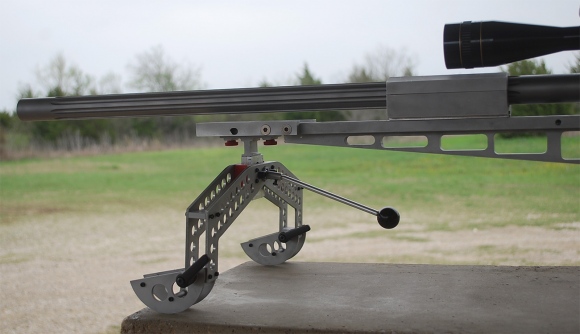
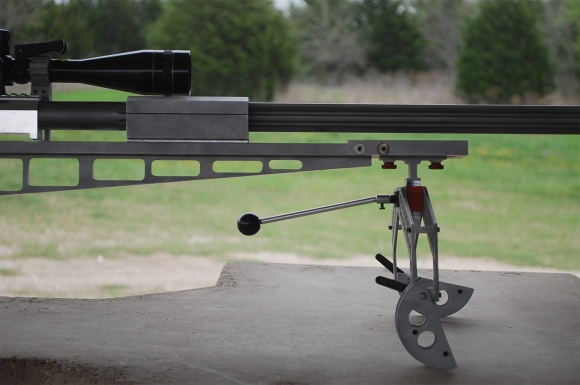









 “Here we go”, I thought as I went for record. Happily, the first six shots found the X-Ring before a 10 came up out of the pits. The next six shots also found the X-Ring, then another 10 came up. Shots 15 thru 19 were all Xs and I finished the string of twenty shots with a final 10. I’d cleaned the 600-yard F-Class target with 17 Xs! This was by far my best “clean” at any distance.
“Here we go”, I thought as I went for record. Happily, the first six shots found the X-Ring before a 10 came up out of the pits. The next six shots also found the X-Ring, then another 10 came up. Shots 15 thru 19 were all Xs and I finished the string of twenty shots with a final 10. I’d cleaned the 600-yard F-Class target with 17 Xs! This was by far my best “clean” at any distance. Dasher Loading Tips
Dasher Loading Tips I use a carbide ball on the expander rod of the full length sizing die. I use a .266″ TiN-coated bushing and the ball just kisses the inside walls of the sized neck. I get very consistent neck tension this way and have had no issue with split necks.
I use a carbide ball on the expander rod of the full length sizing die. I use a .266″ TiN-coated bushing and the ball just kisses the inside walls of the sized neck. I get very consistent neck tension this way and have had no issue with split necks.

 Position shooters can also improve their skills by shooting different disciplines. High Power Across-the-Course shooters benefit from shooting smallbore and air rifle. Again, these targets are very small, which will encourage competitors to be more critical of their shot placement. Hunters may benefit from shooting silhouette matches, which will give them practice when shooting standing with a scoped rifle. Tactical matches may also be good, as tactical matches involve improvising shots from various positions and distances. [Editor: Many tactical matches also involve hiking or moving from position to position -- this can motivate a shooter to maintain a good level of general fitness.]
Position shooters can also improve their skills by shooting different disciplines. High Power Across-the-Course shooters benefit from shooting smallbore and air rifle. Again, these targets are very small, which will encourage competitors to be more critical of their shot placement. Hunters may benefit from shooting silhouette matches, which will give them practice when shooting standing with a scoped rifle. Tactical matches may also be good, as tactical matches involve improvising shots from various positions and distances. [Editor: Many tactical matches also involve hiking or moving from position to position -- this can motivate a shooter to maintain a good level of general fitness.]





 Shiraz tells us: “We come across a lot of shooters who have never shot under a coach. This video was produced to give shooters a basic understanding of shooting with a coach and the importance of releasing a good shot. In a team setting, you basically leave all the decision-making to the coach and aim where you’re told to aim. I’ve worked with Gary many times and it shows in the comfort level we have with each other. The coach plots the shots or a plotter advises the coach of any grouping that is not centered.”
Shiraz tells us: “We come across a lot of shooters who have never shot under a coach. This video was produced to give shooters a basic understanding of shooting with a coach and the importance of releasing a good shot. In a team setting, you basically leave all the decision-making to the coach and aim where you’re told to aim. I’ve worked with Gary many times and it shows in the comfort level we have with each other. The coach plots the shots or a plotter advises the coach of any grouping that is not centered.”





 On his
On his 

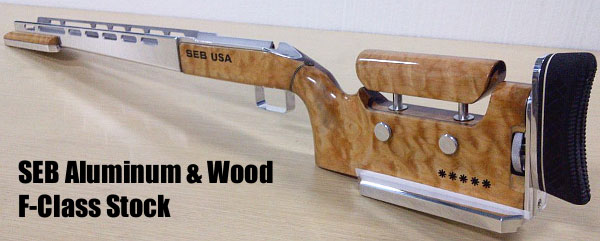





 The Aussies Are Coming!
The Aussies Are Coming!




 Top marksmen from around the world battled for national honors today during Day 1 of the F-Class Team World Championships. F-Open and F-TR teams from many countries were decked out in their national colors. We saw squads from Australia, Brazil, Canada, Great Britain, Ireland, Italy, New Zealand, South Africa, Ukraine, and the USA. Other nations were represented as well.
Top marksmen from around the world battled for national honors today during Day 1 of the F-Class Team World Championships. F-Open and F-TR teams from many countries were decked out in their national colors. We saw squads from Australia, Brazil, Canada, Great Britain, Ireland, Italy, New Zealand, South Africa, Ukraine, and the USA. Other nations were represented as well.




















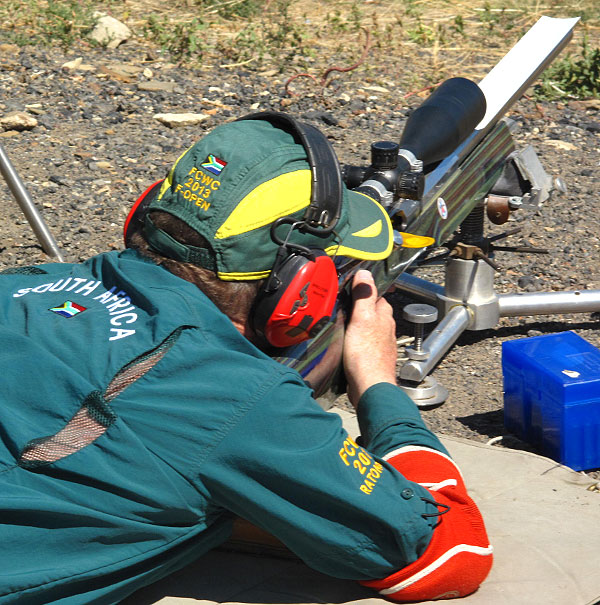







 American Kenny Adams is the new F-Open World Champion, winning the individual title last week at Raton, New Mexico. ‘King Kenny’ rose to the top through with skill, countless days of practice, and great determination. He put in the trigger time, including many long days at Raton. But when we cornered Kenny after his win at the Worlds he was quick to give credit to his gunsmith, Stick Starks of
American Kenny Adams is the new F-Open World Champion, winning the individual title last week at Raton, New Mexico. ‘King Kenny’ rose to the top through with skill, countless days of practice, and great determination. He put in the trigger time, including many long days at Raton. But when we cornered Kenny after his win at the Worlds he was quick to give credit to his gunsmith, Stick Starks of 
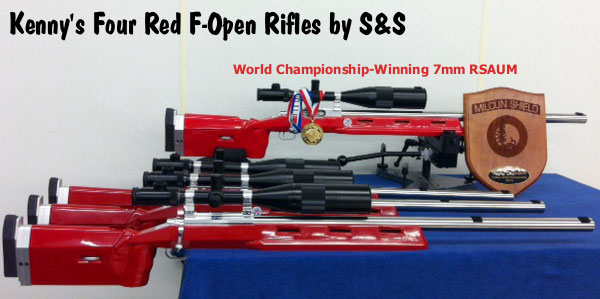



 Doan Trevor built the entire rifle. Doan even made all of the hardware on the gun. Doan was able to drop pounds vs. ounces as a result. Doan’s 3-way butt-plate hardware alone weighs just half a pound! Doan was highly attentive in helping me build the gun the way I wanted. His bedding and fitment is clean and he has creative ideas for the competitive shooter. While my stock is fiberglass, Doan really shines when it comes to building stocks from wood blanks. In fact, Doan built the stock used by second-place finisher Lige Harris, and also fourth-place Trudie Fay. I feel fortunate to have Doan so close. He’s truly a master craftsman who can quickly turn a project into reality.
Doan Trevor built the entire rifle. Doan even made all of the hardware on the gun. Doan was able to drop pounds vs. ounces as a result. Doan’s 3-way butt-plate hardware alone weighs just half a pound! Doan was highly attentive in helping me build the gun the way I wanted. His bedding and fitment is clean and he has creative ideas for the competitive shooter. While my stock is fiberglass, Doan really shines when it comes to building stocks from wood blanks. In fact, Doan built the stock used by second-place finisher Lige Harris, and also fourth-place Trudie Fay. I feel fortunate to have Doan so close. He’s truly a master craftsman who can quickly turn a project into reality.



 At the F-Class Nationals in Raton, we saw a wide variety of front rests being used by F-Open shooters. One that caught our eye was a new prototype
At the F-Class Nationals in Raton, we saw a wide variety of front rests being used by F-Open shooters. One that caught our eye was a new prototype 



 Many styles of bipods were used by F-TR shooters at the F-Class U.S. Nationals and World Championships recently held in Raton, NM. Most featured angled arms — either left/right arms or parallel pairs of arms on either side. With such designs, vertical height is controlled by adjusting the angle of the arms (and hence the distance between the feet). Widen the track and the gun goes down; narrow the track and the gun goes up. One bipod design, Dan Pohlabel’s
Many styles of bipods were used by F-TR shooters at the F-Class U.S. Nationals and World Championships recently held in Raton, NM. Most featured angled arms — either left/right arms or parallel pairs of arms on either side. With such designs, vertical height is controlled by adjusting the angle of the arms (and hence the distance between the feet). Widen the track and the gun goes down; narrow the track and the gun goes up. One bipod design, Dan Pohlabel’s 



